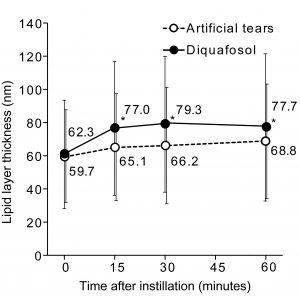Increase in tear lipid layer thickness after diquafosol instillation in healthy human eyes
- research
- April 22, 2017
I’d like to introduce our recent study published in the Ocular Surface’s website.
Fukuoka S, Arita R. Ocul Surf. 2017 Mar 28. pii: S1542-0124(16)30288-9.
The tear film consists of lipid, aqueous, and mucin layers. Diquafosol stimulates both aqueous tear secretion and mucin secretion at the ocular surface. Diquafosol is commercially available as a 3% ophthalmic solution (Diquas; Santen Pharmaceutical Co. Ltd., Japan) in Japan, South Korea, Thailand, and Vietnam for the treatment of dry eye. Administration of lipid emulsion eye drops, lubricant ointment, or a liposomal spray has been shown to increase tear film lipid layer thickness (LLT) as measured by tear interferometry. No topical medication that does not contain lipid or oil has been found to increase LLT, however. We have now examined the effect of diquafosol instillation on LLT in 47 healthy subjects with the use of tear interferometry. We compared the effects of topical instillation of 3% diquafosol ophthalmic solution and artificial tears on tear film LLT in healthy subjects by interferometry. We found that diquafosol significantly increased LLT for up to 60 minutes after instillation, regardless of subject age, whereas artificial tears had no such effect. Our results thus suggest that topical instillation of diquafosol may stimulate lipid secretion from meibomian glands. Further clinical studies are required to determine whether diquafosol instillation is a potential option for management of dry eye and meibomian gland dysfunction.
Please download our free, open access paper.
http://www.theocularsurfacejournal.com/article/S1542-0124(16)30288-9/abstract

Time course of lipid layer thickness (LLT) before and after instillation of artificial tears or 3% diquafosol ophthalmic solution. Diquafosol significantly increased LLT for up to 60 minutes after instillation compared to LLT before instillation, whereas artificial tears had no such effect.

 Celebration for our diquafosol paper acceptance to the Ocular Surface!
Celebration for our diquafosol paper acceptance to the Ocular Surface!


